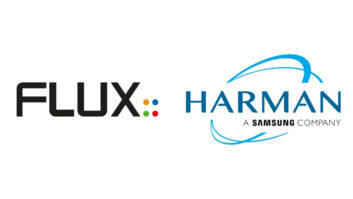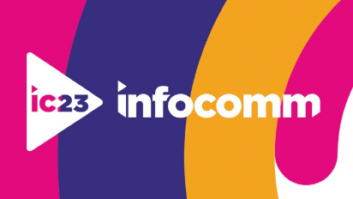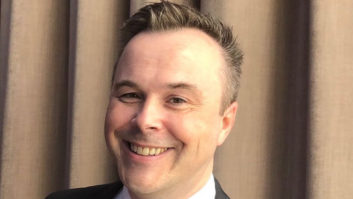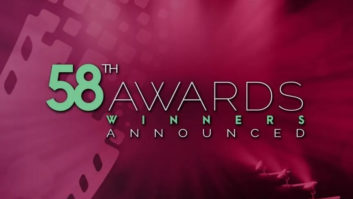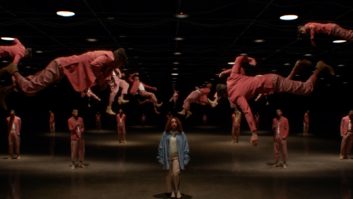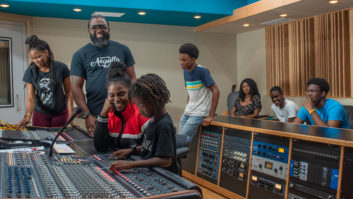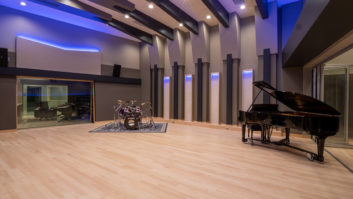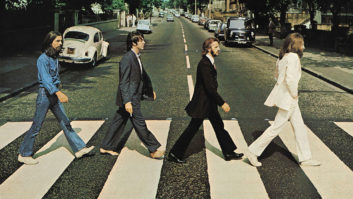If a time capsule took you to a recording studio on Jan 1, 1977, you’d be in an alien, yet strangely familiar world. You might see acoustic drums with a Beyer M88 on kick, Sennheiser 421s on rack toms, an E-V RE-20 on floor tom, a Shure SM57 on snare, Neumann U87s on overheads and an AKG C-414 on hi-hat. So far, nothing’s too weird, but the drums are in a low-ceiling booth attached to the main room, which was finished in dark wood paneling accented by natural rock facings and overhead perforated acoustic tiles.
That small 1977 control room probably had Altec 604 or JBL 4311 monitors — but no near-fields, computers or MIDI gear. The outboard selection might include familiar goodies, such as Pultec EQs or UREI LA-2As, but nothing like the scads of effects toys you find in today’s high-end rooms. The console itself would most likely be a custom design, probably built by the owner and/or chief engineer, a rarity today. Recorder-wise, this 1977 studio likely has a 2-inch analog 16- or 24-track MCI and an Ampex AG-440 2-track. Industry workhorses such as the Ampex ATR-102, Studer A800 and Otari MTR-90 and MX5050 simply don’t exist at this time.
In today’s “typical” (whatever that means) studio, the mic selection is mostly the same, except for high-end ribbons, tube reissues and a preponderance of low-cost knock-offs designed to look like classic models. Those same drums are still there, but for recording, the kit takes center stage in the middle of the main studio. Nowadays, the old “drum booth” is strictly used for overdubs or to iso a guitar amp. But the big difference is in the spacious control room, with its large stereo mains, near-fields and supplemental 5.1 system on speaker stands.
Unlike the control booths of old, modern environments are designed with ample space to work and overdub guitar, bass, keys (virtual or real, synthed or sampled) and sometimes vocals! Today’s console might not even be a console at all; perhaps it is morphed into a workstation controller, providing tactile access to all of those faders and plug-in effects, or as a worksurface controlling racks of audio mixer electronics in a distant machine room. Ironically, today’s studios probably have a greater percentage of tube devices than their counterparts a quarter-century ago. That old 2-inch deck might still be around, but relegated for use as an “effect” in printing rhythm tracks to tape for a phat sound before transfering to disk for editing/processing.
Yet, that pre-PC/pre-MTV/pre-CD/pre-DVD/pre-MP3 year of 1977 when Mix magazine began was enormously significant, and the ensuing months offered just a glimmer of the changes to come in the quarter-century ahead. As a few examples, 1977 ushered in the SSL console, near-field speakers the Apple II (the first PC with color graphics), small-format pro multitracks (Tascam’s 90-16 1-inch 16-track) and the release of commercial digital recordings made using Dr. Tom Stockham’s Soundstream digital system. Always the visionary, Stockham’s paper in the October 1977 Journal of the AES predicted future records on pocket-sized 490MB digital discs, holding 60 minutes of music sampled at 42.5 kHz. Five years later, the CD arrives, storing 60 minutes at 44.1 kHz on a 540MB. The era of digital recording was on its way…
Rather than dwell on the impact of mass-market developments on our industry, such as PCs, Macs, the Internet, MTV, CDs, DVD and the like, we’ll focus on products for studio production. (For more on the changing face of consumer release formats, see Paul Verna’s article on page 12.) Here — listed mostly chronologically — are some key technology breakthroughs that would shape an entire industry during the past 25 years.
ENTER THE MODERN CONSOLE
The world was populated by consoles from companies such as API, Audio Designs, Auditronics, Electrodyne, Harrison, Langevin, MCI, Neve, Opamp (in kit or finished form), Quad-Eight, RCA, SpectraSonics, Sphere and Tascam. Yet, at the 1977 Paris AES, Solid State Logic debuted to pro audio with its first 4000 A Series console — complete with Studio Computer. A UK studio owner remarked: “No one will ever by a console with a television in it.” The A Series had all of the foundations of the 4000 range: in-line channel, small fader, track arming, dynamics on every channel, computerized automation and tape machine control.
NEAR-FIELDS, FOREVER
Also in 1977, Ed Long’s Calibration Standard Instruments unveils the MDM-4 Near-Field Monitor. In 1977, no one predicted the impact this then-revolutionary concept of near-field speakers would have on studios 25 years later. In 1978, Yamaha introduced its now-famed NS-10M — an entry-level home hi-fi speaker, which, unintended for near-field use, eventually became a regular studio fixture everywhere. A decade later, Meyer Sound Labs launched the HD-1, the first serious powered studio monitors, and with the HD-1’s popularity, companies like Genelec — which was successful overseas — brought its high-performance compact designs to the U.S. pro market.
ROTARY DIGITAL
Sony’s 1978 PCM-1600 recording processor stored 2-channel digital audio on rotary head, 3/4-inch video tape. The system (which eventually became the PCM-1610/PCM-1630 format used in CD production) allowed digital editing by using modified video-editing controllers. Four years later, Sony’s PCM-F1 (and later PCM-701/501/601 units) and Nakamichi’s DMP-100 processors offered a consumer method to tape CDs digitally, with selectable 14- or 16-bit operation. Connecting a PCM processor to a VCR (Beta, VHS or U-matic) proved unpopular with consumers, but at $1,900, Sony’s PCM-F1 was a hit with studios. A few stalwart individuals — myself included — made multitrack recordings using two PCM-F1s with multiple synchronized transports. But one thing was certain: The democratization of digital had arrived.
BIG MONEY MULTITRACK DIGITAL
First shown in 1978, 3M’s $115,000 32-track digital multitrack recorded 16-bit, 50kHz audio on 45 ips 1-inch tape and is used on releases such as the self-titled Flim & The BBs and Donald Fagen’s The Nightfly. At the 1980 New York AES, Mitsubishi previewed its X-800, which stored 32 tracks of digital audio on 30 ips 1-inch tape. The format eventually became the PD (ProDigi) standard also used by Otari. In 1981, Sony countered with its $150,000 PCM-3324 digital 24-track, and a year later, Sony, Matsushita, MCI and Studer announced the DASH (Digital Audio Stationary Head) standard, which called for 2/4/8/16/24/48-track formats. By 1988, Sony made good on its promise to deliver a 48-track machine with the PCM-3348. It was $240,000, but sales took off like a rocket.
SAMPLING WORKSTATIONS
The 1978 launch of New England Digital’s Synclavier — the first commercially available, real-time digital synthesis instrument — was a monumental achievement. Over the years, the Synclavier developed from a musical instrument to an all-encompassing digital production environment, by combining keyboard sampling and synthesis with its Tapeless Studio and Direct-to-Disk recording technologies. Australia’s Fairlight began shipping its Series I CMI (Computer Musical Instrument) in 1979. Based on two (!) Motorola 6800 processors, the CMI provided sampling and digital synthesis with a six-octave keyboard, eight-note polyphony, two 8-inch floppy disk drives and a whopping 208K of RAM.
DIGITAL EFFECTS
In 1979, Lexicon shipped its 224 reverb (the ancestor of the company’s 224X/224XL/480L/960L systems), consisting of a console-top controller and rackmount brain with chamber, plate and room programs. The 224 was hailed as “affordable,” meaning $7,900 with four programs, especially compared to the 1980’s $20,000 floor-standing EMT 251 reverb. Reverb prices continued to fall with the 1984 $1,500 Lexicon PCM-60, and in 1985, the first under $1,000 units: the $795 Alesis XT and the $995 ART DR2. A year later, Yamaha hit a home run with the SPX90, which at $745, became a standard fixture in touring and studio racks for years to come.
THE PORTASTUDIO
September 1979 brought TEAC’s Model 144 Portastudio, an integrated 4-track cassette recorder with 3.75 ips operation, and a 4×2 mixer with pan, treble and bass on each input. Tascam’s Portastudios improved considerably over the following years, both in performance and features/flexibility, but for musicians who sought a sketchpad to record musical ideas and demos, the 144 was an overnight sensation.
THE DRUM MACHINE
Roger Linn introduced his Linn Electronics LM-1 Drum Computer — the first programmable drum machine with sampled sounds — in 1980. With its realistic drums, the LM-1 was an instant success, even at $4,995. The term “drum machine” became part of the language, and jobs sprang up for drum machine “programmers.” Pop music would never be the same…
MIDI
After years of backroom meetings between U.S. and Japanese manufacturers, MIDI, the Musical Instrument Digital Interface, was first demonstrated to the public at Winter NAMM 1983, where Sequential Circuits founder Dave Smith used a Prophet-600 to control a Roland synth. At the time, no one imagined the importance of this event, but later that year, some influential MIDI instruments emerged: Yamaha’s DX7 brought FM synthesis to the masses; eventually, Yamaha sold more than 200,000 DX-Series products. At AES 1983, visitors marveled at the Kurzweil 250, the first ROM-based sampling keyboard that successfully reproduced natural-sounding pianos, lush strings and choirs, and more. It was $15,000, and everybody wanted one.
THE TUBE RENAISSANCE
During the ’70s, tubes definitely fell out of general use — except for guitar and power amps. Yet, ironically, it was the edginess of early digital systems that brought tubes back to the studio forefront, with companies such as Denmark’s Lydkraft (Tube-Tech) and California-based Summit Audio leading the way with high-performance, ultra-smooth tube EQs. In 1983, AKG’s “The Tube” mic was a modern update of the classic C-12, which began the trend of new and reissue tube mics from many companies. James Demeter expanded the tube gear genre with his 1991 Tube Direct Box, and by AES 1995, more than 25 companies displayed equipment using vacuum-tube technology. Today, the list is even longer…
SAMPLERS GO AFFORDABLE
E-mu Systems’ 1984 Emulator II sampler was light years ahead of its predecessor in terms of sound quality and processing power. It retailed at $8,500, and over the next four years, the EII and other E-mu products became standard fixtures in studios everywhere. Later that year, Ensoniq launched its Mirage, the first mass-market sampler. At $1,700, and backed by an excellent library of sounds, it was highly successful, although do-it-yourself sample creation on the unit was nearly impossible. Two years later, Akai’s S900 sampler’s affordable price ($3,295), quality audio and great library (which grew to mammoth proportions) appealed to the musician/studio market, while the post-production community loved them for effects triggering. It was a hit.
LUCASPRO!
Lucasfilm and Convergence Corp. formed The Droid Works and unveiled its SoundDroid workstation in 1985. It offered picture-interlocked multitrack recording, sound synthesis, editing, mixing, reverb and effects from a slick interface of touch-sensitive screens, assignable knobs, moving faders and shuttle wheel — a spellbinding technological achievement. A year later, commercial systems were offered to the public, but it was years before its time and the company folded. Later, former Droid Works execs formed Sonic Solutions, and in 1987, offered its NoNoise services for removing hiss, noise, clicks and pops from recordings. Eventually, the company expanded into stereo DAWs, unveiled the first 24-track editing/mixing workstation and developed the first DVD-authoring system.
PRICEY LOOPS
In 1986, Optical Media International released The Universe of Sounds, a $1,200 single CD (!) of samples for the Emulator II. The Sony CD-ROM drive that went with it was $2,000. It’s expensive, but as with all revolutions, you gotta start somewhere. That same year, Digidesign debuted Sound Designer, a Mac program to edit and manipulate EII samples. Sound Designer also offered FFT analysis, digital EQ/mixing/compression, FM and waveshaping synthesis, and waveform redrawing using a mouse — all components of its 1989 Sound Tools System.
DAT
After years of home digital audio tape format squabbles over stationary (S-DAT) or rotary (R-DAT) head technologies, the latter won in 1987. A year later, no consumer DATs were officially delivered stateside, due to the RIAA’s attempts to legislate copy-code circuits in DATs, to prevent duplicating CDs. However, pro DATs — such as Sony’s PCM-2500 and Panasonic’s SV-3500 — were allowed into the country. Three years later, manufacturers had to include SCMS (Serial Copy Management System) on consumer DAT decks. Pro gear was exempt from SCMS, yet it was appeared on some pro recorders, as manufacturers feared litigation if consumers bought pro machines to avoid SCMS. Ironically, by this time, DAT was considered a failure as a home format, and the net effect of SCMS made it difficult for bands who worked on home digital equipment to create back-up copies of their own works. Thanks, RIAA!
CD-R
Tandy announced the vaporware THOR erasable CD system in 1988, with the promise of under-$500 CD recorders and $25 media. Using 1988 technology it was impossible to do, but the buzz about THOR caused CD player sales to plummet as consumers postponed buying CD systems until the “recordable” ones came out. A year later, a “real” ones came out: Gotham’s CDR-90 CD recording system. It was $70,000: Ouch! But by 1989, the first “affordable” CD-R arrived: the stand-alone, rackmount Marantz CDR-600. Price was “only” $7,500. A decade later, tabletop CD-R units were less than $1,000, and under $100 CD-R computer drives were commonplace.
MDMS
Unveiled in 1988, Akai’s A-DAM (Akai-Digital Audio Multitrack) stored 12 tracks on 8mm videotape in an 80-pound, rackmount chassis and used the modular digital multitrack (MDM) approach, where multiple tape transports could be slaved for more tracks. It was $35,000, but a bargain compared to the $100,000-plus prices on reel-to-reel digital machines. The recording world turned upside down on January 18, 1991, when Alesis launched the $3,995 ADAT, which offered 8-track digital audio recording on S-VHS tapes and interlocked up to 16 transports for 128 tracks. ADAT was 14 months away from deliveries, but immediately brought analog 8-track sales to a halt. Affected most by the advent of ADAT, Tascam began its own MDM development and showed the DA-88 in 1992. Digital multitracking was no longer the realm of the rich and famous.
THE AFFORDABLE DAW
In 1989, Digidesign unveiled Sound Tools, a Mac-based digital recording/editing system that combined custom outboard converters and DSP with its Sound Designer II software. At $3,995, it was ideal for editing tracks on those DAT machines in studios everywhere. Even today, the SD II file format remains a worldwide standard. Two years later, Digi launched Pro Tools, a Mac-based system that integrated multitrack digital audio recording/editing, DSP and onscreen digital mixing. Systems were priced from $5,995 — a fraction of the $100,000-plus NED Direct-to-Disk systems it competed with.
LOW-COST ANALOG
Also in 1989, Mackie Designs — a new company formed by the founder of Tapco — debuted the CR-1604, a 16-channel design, but in an all-metal chassis with an internal power supply and seven aux sends per channel. The concept of a rugged, clean-sounding, affordable console took the industry by surprise, and the process repeated three years later with Mackie’s 8•Bus line, with a 24-channel, 8-bus mixer priced less than $4,000. With affordable mixers, MDMs and MIDI, the project studio movement was underway, leading to a surge in basement and bedroom studios.
DIGITAL SEQUENCERS
The talk of Winter NAMM 1990 was Opcode’s Studio Vision, a digital audio sequencer that combined MIDI sequencing with the digital audio capability of Digidesign’s Sound Tools. Audio data showed up as tracks of waveforms and could be cut/pasted/manipulated as easily as MIDI tracks in a conventional sequencing program. The concept caught on, and other digital sequencers, such as MOTU’s Digital Performer, Steinberg’s Cubase Audio, Emagic’s Logic Audio and Cakewalk Audio, entered the market.
PLUG-INS
By 1994, third-party software “plug-ins” (which brought new functions and features to existing programs) caught on with non-audio applications, such as PhotoShop and QuarkExpress. With the rising number of Digidesign systems in the world, outside software developers expanded the market with audio plug-ins for Sound Designer II and Pro Tools applications, and companies such as Waves, Jupiter Systems and Arboretum Systems were ready for this new industry. Later in the year, Digidesign shipped its TDM system — the open-architecture, 256-channel, 24-bit digital audio bus for Pro Tools — which opened new opportunities for plug-in developers. Eventually, the plug-in market expanded to other platforms such as MOTU MAS, Steinberg VST and general-purpose DirectX systems.
DIGITAL MIXERS BECOME AFFORDABLE
In 1995, Yamaha’s under-$10,000 02R 20-bit, digital 8-bus console, took off, offering 24 analog inputs and 16 digital tape returns (40 total inputs) and four card slots, accommodating various digital formats. Standard were moving faders, instantaneous reset of all parameters, limiter/compressor/gate on every channel, and two internal effects processors. Paired with a couple of MDMs, the all-digital studio was no longer a fantasy. By 2000, as 02R sales ebbed, Sony launched its $20,000 DMX-R100 “Baby Oxford,” a 48-channel, 24-bit, 96kHz-capable digital board, with full automation, color touchscreen parameter and control of 5.1 surround panning. In late 2001, Yamaha countered with the DM2000, a $20,000, 96-input console designed for true 24/96 production, with the processing power of nine 02Rs and no channel “loss” in 96kHz mode. Earlier this year, the 02R was replaced by the 02R96, a 56-input, 24-bit/96kHz board with full mix interfacing with popular DAWs.
PERSONAL DIGITAL STUDIOS
Roland’s 1996 VS-880 Digital Studio combined a disk-based 8-track recorder/editor with a 14-channel digital mixer and two optional effects processors. The VS-880 was followed by similar offerings from Yamaha, Fostex, Korg, Tascam, Akai and expanded VS-Series models from Roland. The one-piece, no-computer-required approach was enormously popular, particularly with entry-level users. It created the most successful launch of a new product genre since the ADAT in 1991.
AND THE REST…
Is it over? No way; in fact, we’re not even near the end of the race. However, as always, the audio industry is filled with ironies: While we wait in anticipation for the newest digital toys, the hottest product for big studios is high-performance, a-n-a-l-o-g consoles, with new models — such as the SSL XL9000 K Series and Neve 88R — installed in studios that 18 months ago would have only considered digital. Meanwhile, large digital consoles have been readily accepted by the broadcast industries in fixed suites and remote trucks. However, there’s no denying that the future of audio is not only digital, but also computer-based. Touchscreens, joysticks and dedicated control surfaces are replacing traditional consoles at a rapid clip, especially with today’s versatile plug-ins and virtual instruments. FireWire (IEEE 1394) and USB peripherals interface easily with laptops and desktop computers; and with the staggering increases in the power of today’s Macs and PCs, high-resolution, true native processing is a reality, making us less dependent on banks of outboard DSP.
At the same time, large-scale project backups via low-cost DVD-R media (well under $2 these days), and the excellent cost/performance ratios offered by DV video and 24-bit/96kHz desktop digital audio systems for stereo or surround production make broadcast-quality tools available to nearly anyone. Just add some creativity and start your own media revolution.
